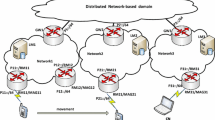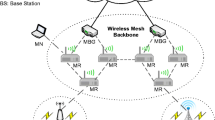Abstract
Currently, IP mobility management solutions standardized by IETF rely on a centralized and static mobility approach, whereby a central mobility anchor manages mobility signaling and data traffic forwarding. All data traffic sent to a mobile node (MN) traverse the central mobility anchor regardless the current point of attachment of the MN in the Internet. Consequently, the packets follow a non-optimal path via the central mobility anchor which is typically located in the MN’s home network, and result to increase in packet delivery latency. This paper discusses a distributed mobility management mechanism that releases the burden of the central mobility anchor by splitting the mobility management functions of the mobility anchor and co-locating the mobility routing function at the gateway of each sub-network. This mechanism optimizes the data path of the MN that has moved to visited networks, which reduces the packet delivery latency. Moreover, the mechanism is extended to achieve seamless handover when the MN moves between visited networks. Through simulation under NS-2, the performance of the packet delivery latency, handover delay and packet loss is studied and analyzed with respect to varying network load and increasing distance of the MN’s home network from the visited networks. Simulation results show the improvement in packet delivery latency as compared to using non-optimized paths. Moreover, the results also verify the achievement of seamless handover when an MN moves between visited networks.



















Similar content being viewed by others
Abbreviations
- AR:
-
Access Router
- CBR:
-
Constant Bit Rate
- CN:
-
Correspondent Node
- CoA:
-
Care-of-Address
- DMM:
-
Distributed Mobility Management
- DS-MIPv6:
-
Dual Stack Mobile IP version 6
- GSM:
-
Global System for Mobile Communications
- GW:
-
Gateway Router
- HA:
-
Home Agent
- HNP:
-
Home Network Prefix
- HoA:
-
Home Address
- IETF:
-
Internet Engineering Task Force
- IP:
-
Internet Protocol
- LM:
-
Internetwork Location Management
- LMA:
-
Local Mobility Anchor
- MAG:
-
Mobile Access Gateway
- MIPv6:
-
Mobile IP version 6
- MN:
-
Mobile Node
- MR:
-
Mobility Routing
- NIST:
-
National Institute of Standard and Technology
- NS-2:
-
Network Simulator Version 2
- NEMO:
-
Network Mobility
- Net:
-
Network
- PMIPv6:
-
Proxy Mobile IP version 6
- POA:
-
Point of Attachment
- PSTN:
-
Public Switched Telephone Network
- TCP:
-
Transmission Control Protocol
- TMAG:
-
Tracking Mobile Access Gateway
- UDP:
-
User Datagram Protocol
- UMTS:
-
Universal Mobile Telecommunication System
References
Bertin, P., Bonjour, S., & Bonnin, J.-M. (2008). A distributed dynamic mobility management scheme designed for flat IP architectures. In New Technologies, Mobility and Security (NTMS ’08) (pp. 1–5).
Bertin, P., Bonjour, S., & Bonnin, J.-M. (2009). Distributed or centralized mobility? In IEEE Global Telecommunications Conference (GLOBECOM) (pp. 1–6).
Bertin, P., Bonjour S., & Bonnin J.-M. (2009). An evaluation of dynamic mobility anchoring. In IEEE 70th vehicular technology conference fall (VTC 2009-Fall) (pp. 1–5).
Chan, H. A. (2010). Proxy mobile IP with distributed mobility anchors. In IEEE GLOBECOM Workshops (GC Wkshps) (pp. 16–20).
Chan, H. A. (2012). Distributed mobility management with mobile IP. In International communication conference (ICC), workshop on telecommunications: From research to standards (pp. 6850–6854).
Chan, H. A., Yokota, H., Xie, J., Seite, P., & Liu, D. (2011). Distributed and dynamic mobility management in mobile Internet: Current Approaches and Issues. Journal of Communications, 6(1), 4–15.
Cisco Visual Networking Index: Global Mobile Data Traffic Forecast Update, 2011–2016. White Paper (February 2012). http://www.cisco.com/en/US/solutions/collateral/ns341/ns525/ns537/ns705/ns827/white_paper_c11-520862.html.
Devarapalli, V., Wakikawa, R., Petrescu, A., & Thubert, P. (January 2005). Network mobility (NEMO) basic support protocol. IETF RFC 3963 (proposed standard).
Distributed Mobility Management. http://datatracker.ietf.org/wg/dmm/.
Ernest, P. P., Chan, H. A., & Falowo, O. E. (2012). Distributed mobility management scheme with mobility routing function at the gateways. In IEEE global communications conference (GLOBECOM) (pp. 5254–5259).
Giust, F., De La Oliva, A., Bernardos, C. J., & Da Costa, R. P. F. (2011). A network-based localized mobility solution for distributed mobility management. In: Wireless personal multimedia communications (WPMC), international workshop on mobility for flat networks (MMFN), 2011 (pp. 1–5).
Giust, F., De La Oliva, A., & Bernardos, C. J. (2011). Flat access and mobility architecture: An IPv6 distributed client mobility management solution. In IEEE conference on computer communications workshops (INFOCOM WKSHPS) (pp. 361–366).
Gundavelli, S., Leung, K., Devarapalli, V., Chowdhury K., & Patil, B. (August 2008). Proxy Mobile IPv6. IETF RFC 5213 (proposed standard).
Johnson, D., Perkins, C., & Arkko J. (July 2011). Mobility Support for IPv6. IETF RFC 6275 (proposed standard).
Lee, K.-H., Lee, H.-W., Ryu, W., & Han, Y.-H. (2011). A scalable network-based mobility management framework in heterogeneous IP-based networks. Telecommunication Systems. doi:10.1007/s11235-011-9479-3.
Li, C.-S., Lin, F., & Chao, H.-C. (2009). Routing optimization over network mobility with distributed home agents as the cross layer consideration. Telecommunication Systems, 42, 63–76.
Nascimento, A., Sofia, R., Condeixa, T., & Sargento, S. (2012). A decoupling approach for distributed mobility management. In the 21st international conference on computer communications and networks (ICCCN) (pp. 1–6).
NS-2 Network Simulator. http://www.isi.edu/nsnam/ns.
Park, W., Choi, J., & Kim, B. (2007). Scheme for improving transmission performance of realtime traffic using priority queues in HMIPv6. Telecommunication Systems, 36, 3–11.
Pentikousis, K., Zhou, Q., & Wang, H. (2011). Design considerations for mobility management in future infrastructure networks. In Telecom World (ITU WT), Technical Symposium at ITU (pp. 87–92).
PMIPv6 for NS-2 patch and required packages. Accessed October 2012. http://commani.net/pmip6ns/download.html.
Sadhukhan, P., Das, P. K., & Saha, S. (2011). Hybrid mobility management scheme integrating mobile IP and SIP for seamless invocation of service in All-IP network. Telecommunication Systems. doi:10.1007/s11235-011-9483-7.
Soliman, H. (ed.) (June 2009). Mobile IPv6 support for dual stack hosts and routers. IETF RFC 5555 (proposed standard).
Soliman, H., Castelluccia, C., ElMalki, K., & Bellier, L. (October 2008). Hierarchical Mobile IPv6 (HMIPv6) Mobility Management. IETF RFC 5380 (proposed standard).
Thomson, S., Narten, T., & Jinmei, T. (September 2007). IPv6 stateless autoconfiguration. IETF RFC 4862 (proposed standard).
Vasilache, A., Li, J., & Kameda, H. (2003). Threshold-based load balancing for multiple home agents in mobile IP networks. Telecommunication Systems, 22(1–4), 11–31.
Wakikawa, R., Valadon, G., & Murai, J. (2006). Migrating home agents towards internet-scale mobility deployments. In Proceedings of ACM conference on future networking technologies (CoNEXT’06).
Zhang, L., Wakikawa, R., & Zhu, Z. (2009). Support mobility in the global internet. In 1st ACM workshop on mobile internet through cellular networks ( MICNET’09) (pp. 1–6).
Author information
Authors and Affiliations
Corresponding author
Rights and permissions
About this article
Cite this article
Ernest, P.P., Chan, H.A., Xie, J. et al. Mobility management with distributed mobility routing functions. Telecommun Syst 59, 229–246 (2015). https://doi.org/10.1007/s11235-014-9958-4
Published:
Issue Date:
DOI: https://doi.org/10.1007/s11235-014-9958-4




